The overall fisheries production in Region I declined by 17.3 percent in 2nd quarter 2018. From the total output of 44,479 metric tons a year ago, it went down to 36,804 metric tons this year.
All the provinces posted decreases in output. All the three subsectors registered downtrends. The aquaculture contributed 83.1 percent to fisheries output. The municipal and commercial fisheries accounted 14.9 percent and 2.0 percent, respectively.
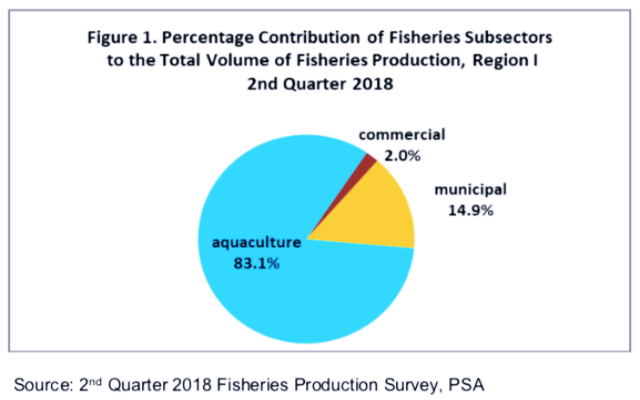
In terms of provincial distribution, the province of Pangasinan shared the bulk of production of about 77.4 percent. The overall volume of production of the province was posted at 28,468 metric tons, or 19.8 percent lower than its production in the same period of 2017. The production of its aquaculture and commercial subsectors declined by 21.3 percent, and 49.0 percent, respectively. Meanwhile, the municipal subsector grew by 9.5 percent.
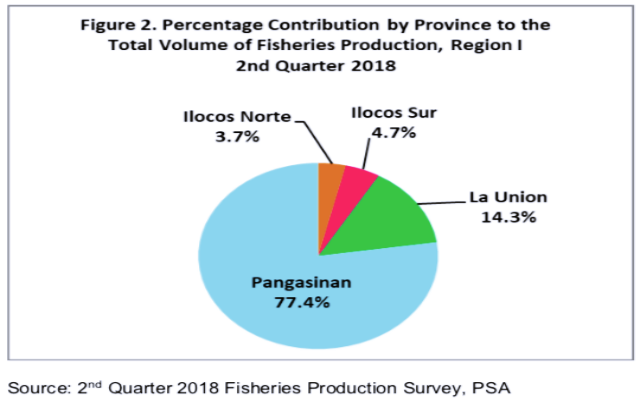
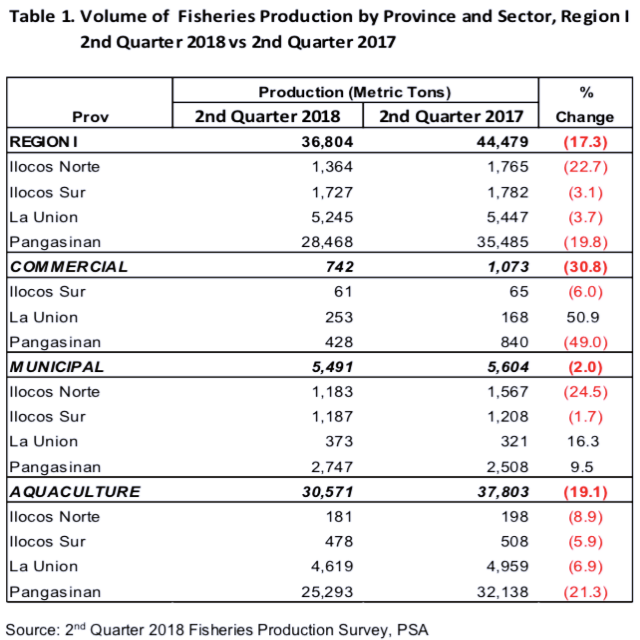
The province of La Union registered lower fisheries production in 2nd quarter 2018 as compared with the level a year ago. From 5,447 metric ton production last year, it went down to 5,245 metric tons this year. The decline in the output of the aquaculture sub-sector caused the overall downtrend.
The fisheries production of Ilocos Sur also registered negative growth in 2nd quarter 2018. Its output was recorded at 1,727 metric tons, or 3.1 percent lower than the production in 2nd quarter 2017 of 1,782 metric tons.
The fisheries production of Ilocos Norte went down by 22.7 percent in 2nd quarter 2018. Its output was posted at 1,364 metric tons, lower than the output of 1,765 metric tons a year ago. Both the municipal and aquaculture subsectors registered negative growths.
Commercial Fisheries
The commercial fisheries volume of production in Region I went down by 30.8 percent in 2nd quarter 2018. Its output was posted at 742 metric tons, lower than the output in the same period in 2017 of 1,073 metric tons. The provinces of Ilocos Sur and Pangasinan posted a lower output. Lesser fishing operations due to continuous rains brought by the southwest monsoon and drydocking and repair of some fishing boats were the factors that contributed to the overall decline in production.
In terms of provincial shares, Pangasinan accounted for 57.7 percent of the region’scommercial fisheries volume of production in 2nd quarter 2018. It was followed by La Union with 34.1 percent share and Ilocos Sur with 8.3 percent share.
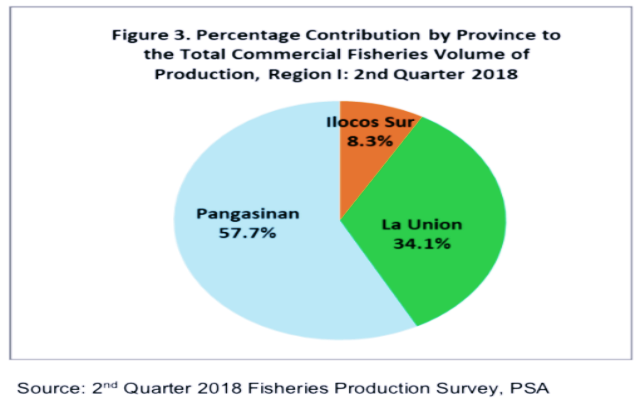
The top five major catch in the region during the 2nd quarter 2018 were Roundscad, Skipjack, Threadfin bream, Indo-pacific mackerel, and Slipmouth.
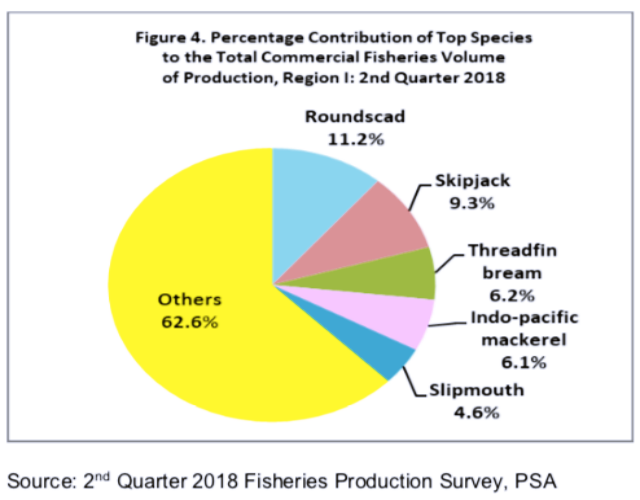
Municipal Fisheries
The overall municipal fisheries production of Region I in 2nd quarter 2018 showed a downtrend. The production was posted at 5,491 metric tons, lower than the output in 2nd quarter 2017 of 5,604 metric tons. The lesser catch in the marine municipal fisheries pulled down the overall output of the sub-sector.
Marine Municipal
Production of Marine Municipal Fisheries in Region I in 2nd quarter 2018 was posted at 5,106 metric tons, lower than the output a year ago of 5,293 metric tons. The provinces of Ilocos Norte and Ilocos Sur posted decrement in output. Lesser fishing operations due to rough seas and frequent rains and increased price of gasoline caused the overall decline.
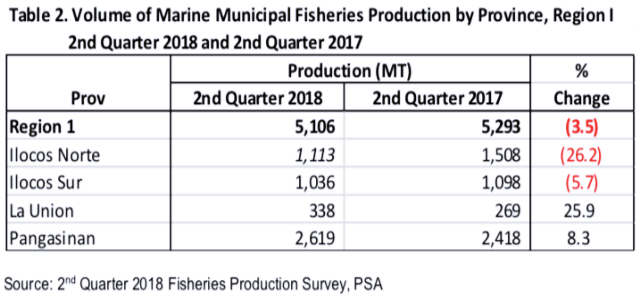
The province of Pangasinan contributed 51.3 percent to the region’s marinemunicipal fish catch during the period, followed by Ilocos Norte with 21.8 percent share, Ilocos Sur with 20.3 percent share, and La Union with 6.6 percent. The dominant catch in marine municipal waters were Squid, Rounscad, Flying fish, Bigeye tuna, and Threadfin bream.
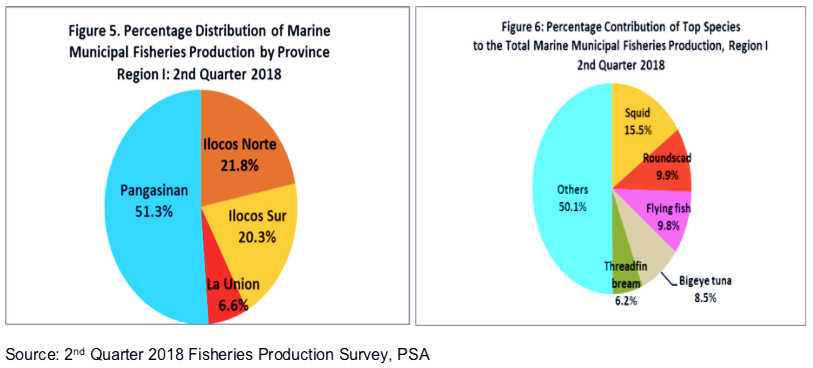
Inland Municipal Fisheries
Production of Inland Municipal Fisheries in Region I grew by 23.8 percent in 2ndquarter 2018. From its output of 311 metric tons in the same period last year, it went up to 385 metric tons this year. All the provinces, except La Union, posted higher outputs. More fishing days due to demand and favorable water level in rivers, more fish shelters set, and good water parameters as a result of dredging and clearing of rivers contributed to the overall increase in production.
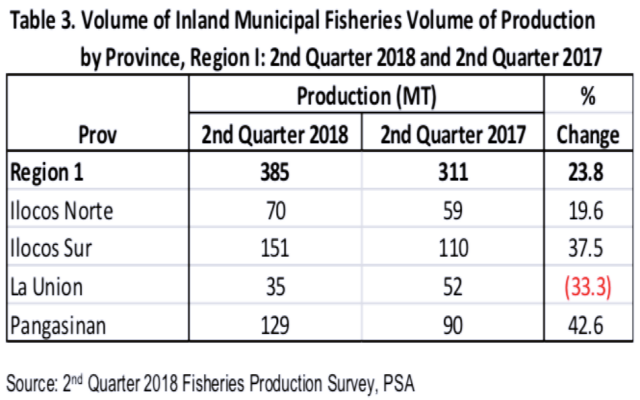
By province, Ilocos Sur ranked first in terms of volume of production of Inland municipal fisheries during the second quarter 2018 with 39.3 percent share. It was followed by Pangasinan with 33.4 percent share, Ilocos Norte with 18.2 percent, and La Union 9.0 percent. The top five major catch in the region during the period were Tilapia, Freshwater goby, Freshwater shrimp, Blue crab, and Endeavor prawn.
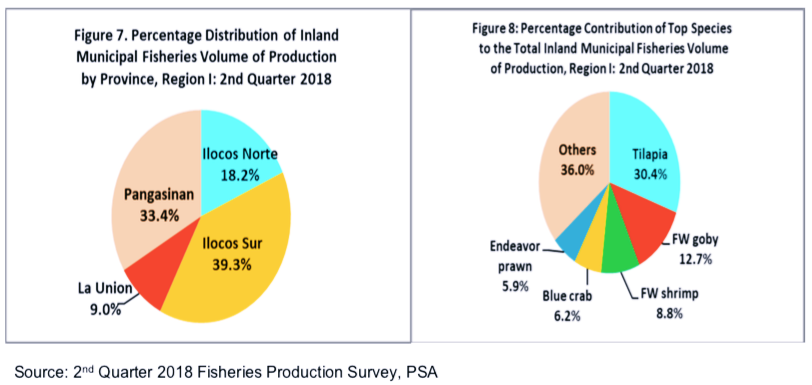
Aquaculture
Aquaculture production of Region I was pegged at 30,570.71 metric tons in 2ndquarter 2018. It is lower than the output a year ago of 37,803 metric tons. Almost all ecosystems registered negative growth in output as the majority of stocks were harvested in 1st quarter 2018. Lower survivability was also observed. Furthermore, the incidence fish kill in Anda and Bolinao, Pangasinan triggered the overall decline in output.
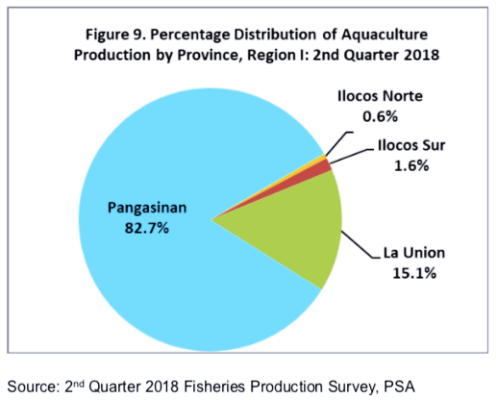
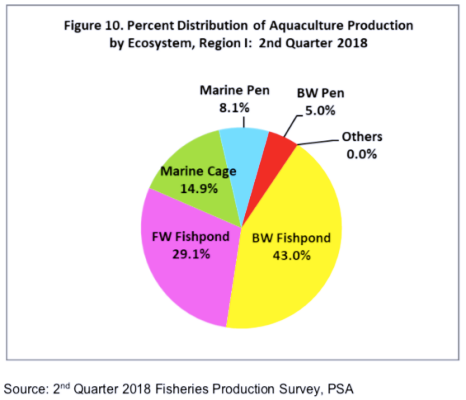
Milkfish dominated the aquaculture production of Region I with a share of 56.3 percent. Its production during the period was posted at 17,226 metric tons, lower than its output in the same quarter last year of 26,062 metric tons. The factors that contributed to the lower output include lower survivability, smaller sizes of produce, an incidence of fish-kill, and shifting from fingerlings production.
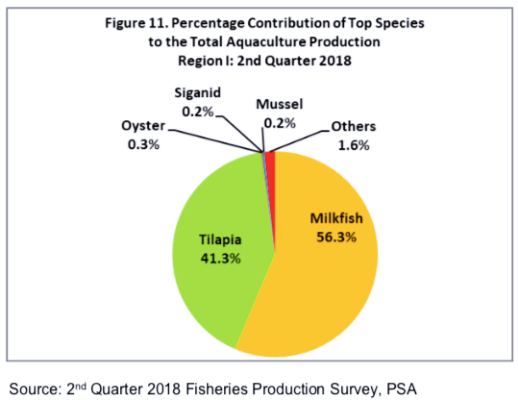
TECHNICAL NOTES
-
-
-
The Fisheries Production Survey of the Philippine Statistics Authority (PSA) is divided into four (4) major fisheries surveys. These are the Quarterly Commercial Fisheries Survey (QCFS), Quarterly Municipal Fisheries Survey (QMFS), Quarterly Inland Fisheries Survey (QIFS) and Quarterly Aquaculture Survey (QAqS). The commercial and municipal fisheries surveys aim to provide quarterly data on volume and value of fish production by species, by region, and by province. The aquaculture survey is intended to generate quarterly data on volume and value of cultured species by environment, by type of aquafarm, by region, and by province.
-
-
Concepts and Definitions:
-
-
Aquaculture – fishery operation involving all forms of raising and culturing of fish and other fishery species in marine, brackish and freshwater environment. Examples are fishponds, fish pens, fish cages, mussel, oyster, seaweed farms and hatcheries.
Aquafarm – the farming facilities used in the culture or propagation of aquatic species including fish, mollusk, crustaceans, and aquatic plants for purposes of rearing to enhance production.
Brackishwater – mixture of seawater and freshwater with salinity that varies with the tide. Example are estuaries, mangroves, and mouths of rivers where seawater enters during high tide.
Commercial Fishing – the catching of fish with the use of fishing boats with a capacity of more than three (3) gross tons for trade, business or profit beyond subsistence or sports fishing.
Fisheries – all activities relating to the act or business of fishing, culturing, preserving, processing, marketing, developing, conserving and managing aquatic resources and the fishery areas including the privilege to fish or take aquatic resources thereof (RA 8550).
Fisheries Sector – the sector engaged in the production, growing, harvesting, processing, marketing, developing, conserving and managing aquatic resources and fishing areas.
Fish Cage – stationary or floating fish enclosure made of synthetic net wire/bamboo screen or other materials set in the form of an inverted mosquito net (“hapa” type) with or without cover with all sides either tied to poles stakedto the water bottom or with anchored floats for aquaculture purposes.
Fishing Gear – any instrument or device and its accessories utilized in taking fish and other fishery species.
Fishing Grounds – areas in any body of water where fish and other aquatic resources congregate and become the target of capture.
Fish Pen – an artificial enclosure constructed within a body of water for culturing fish and fishery/ aquatic resources made up of bamboo poles closely arranged in an enclosure with wooden materials, screen or nylon netting to prevent an escape of fish.
Fishpond – a body of water (artificial or natural) where fish and other aquatic products are cultured, raised or cultivated under controlled conditions. This is a land-based type of aquafarm. Note that the setting-up of fish cages in ponds does not make the operation of a fish cage and at the same time a fishpond.
Freshwater – water without salt or marine origins, such as generally found in lakes, rivers, canals, dams, reservoirs, paddy fields, and swamps.
Inland Municipal Fishing – the catching of fish, crustaceans, mollusks and all other aquatic animals and plants in inland water like lakes, rivers, dams, marshes, etc. using simple gears and fishing boats some of which are non- motorized with a capacity of three (3) gross tons or less; or fishing not requiring the use of fishing boats.
Landing Center – a place where the fish catch and other aquatic products are unloaded and traded.
Municipal Fishing – covers fishing operation carried out with or without the use of a boat weighing three (3) gross tons or less.


